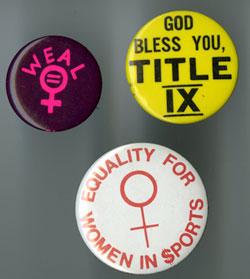Introduction

Can equality be achieved through law?
Module summary
Title IX of the Education Act Amendment of 1972 offers women a legal weapon with which to contest discrimination in education, including admissions, athletics, financial aid, extracurricular activities, and academic programs. Sponsored by members of Congress, including Edith Green, Patsy Mink and Birch Bayh, the provision parallels Title IV of the
Civil Rights Act of 1964 which bars race discrimination in education.
Although the U.S. Constitution is the foundation of the government, the opening phrase, "We, the people," did not inherently include women in its vision. Prior to gaining greater rights, women held second class citizen status as they were under the guise of their male family members. In an effort to be recognized as individuals, women fought for political and economic rights. The first major legal victory occurred on August 18, 1920, when the Nineteenth Amendment to the Constitution was ratified, which stated "The right of citizens of the United States to vote shall not be denied or abridged by the United States, or by any State on account of sex." [See Women's Suffrage Lesson]
The 1920s was a golden time for women. With the power to vote, women became active in a wide variety of social issues, from concerns about child labor to the plight of the poor, splintering their focus into many directions. They began to enter colleges and graduate schools in record numbers and soon made up nearly half of the students at many universities. Progress would be limited, as the United States fought the Great Depression at home and totalitarianism abroad. It would not be until the late 1950s and 1960s that the women's movement began to fight for broader rights, especially economically and socially. [See Social Protests of the 1960s and 1970s Module]
The year 1972 marked a pivotal year in the Women's Rights Movement. The United States Congress passed several important laws for women. The broadest was the Equal Rights Amendment (ERA), an addition to the United States Constitution that have would guaranteed women the same rights as men. Though the ERA had been introduced in every session of Congress since 1923, it had died in Congressional Committee every time. This proposed Amendment faced harsh criticism, and although in 1972 it was finally passed by Congress, the ERA was not able to be ratified by enough states. Although it has never been included in the Constitution, the ERA continues to be debated.
That same year Congress passed a narrow and modest law, Title IX of the Education Amendments of 1972, while it also faced criticism; overall it proved to be successful. Today, Title IX remains one of the nation's most controversial and important civil rights laws.
Quoted and/or adapted from:
Activity explanation
- American Ideals and Title IX
- Examine Title IX in context of American ideals.
- Compare Title IX to other historic legal documents.
- Title IX: Support and Fears
- Explore perceptions of Title IX from its inception in 1972.
- Students will debate about the historic merits and fears that emerged about Title IX.
- Process and Implementation of Title IX
- Examine documents that explain how schools and universities had to learn to comply with Title IX.
- Study the origins of Rutgers' women's athletic program.
- Rutgers in Transition
- Explore the changes that women's athletics and activities underwent through a photo album containing images from 1922 through 2005.
- Political Cartoon Analysis
- Analyze political cartoons about Title IX.
- Evaluate Title IX's impact on economics.
- Case Study: Women's Basketball at Rutgers University
- Explore the history of women's basketball in America and at Rutgers University.
- Compare the evolution of women's basketball to the evolution of American women.
- Uniform Analysis: Cheerleading
- Learn about the history of cheerleading and uniforms through photograph analysis.
- Continued Battles for Equality
- Evaluate the shortfalls and achievements of Title IX since its inception through primary sources.
- Explore the current status of Title IX.